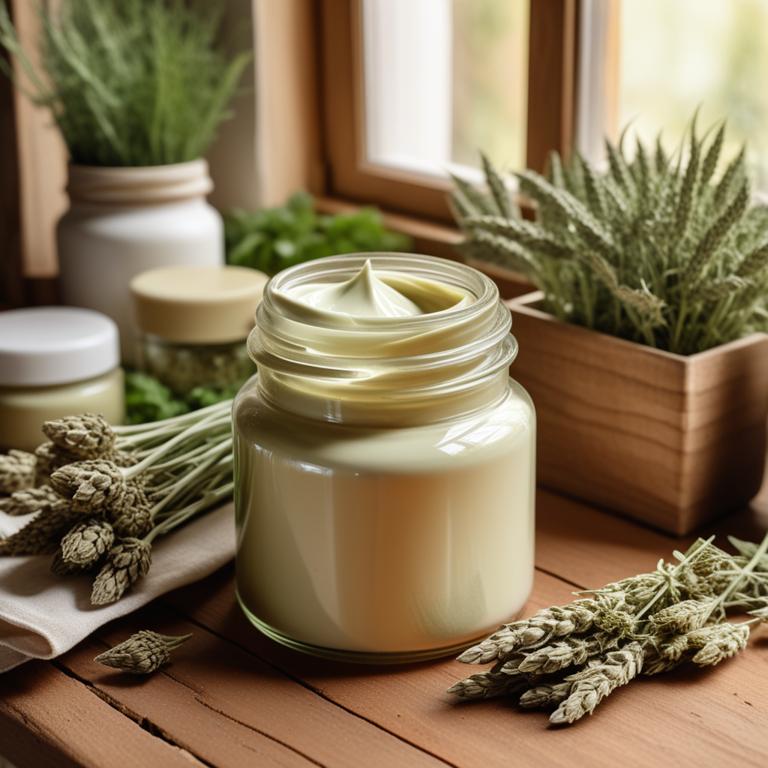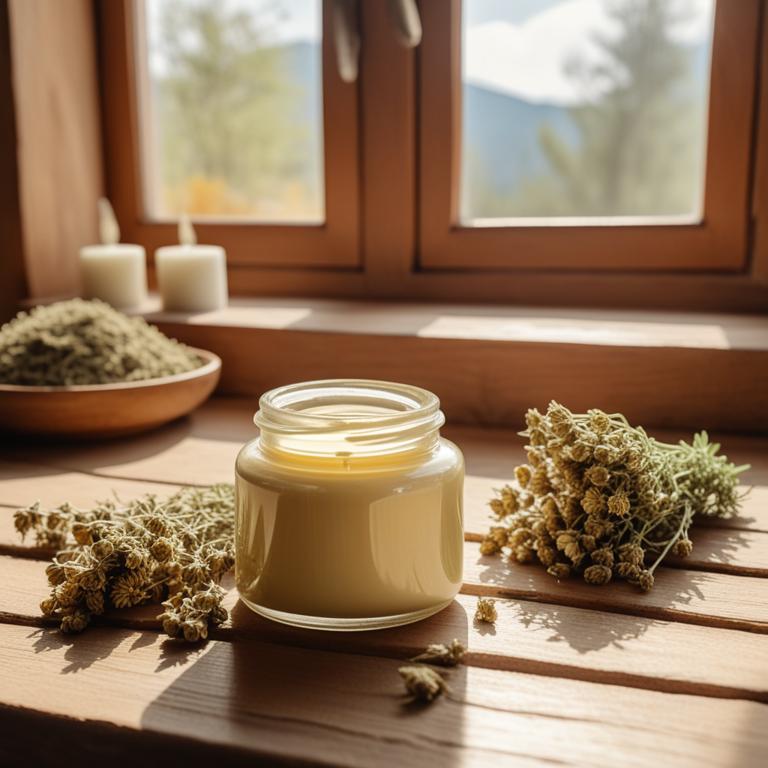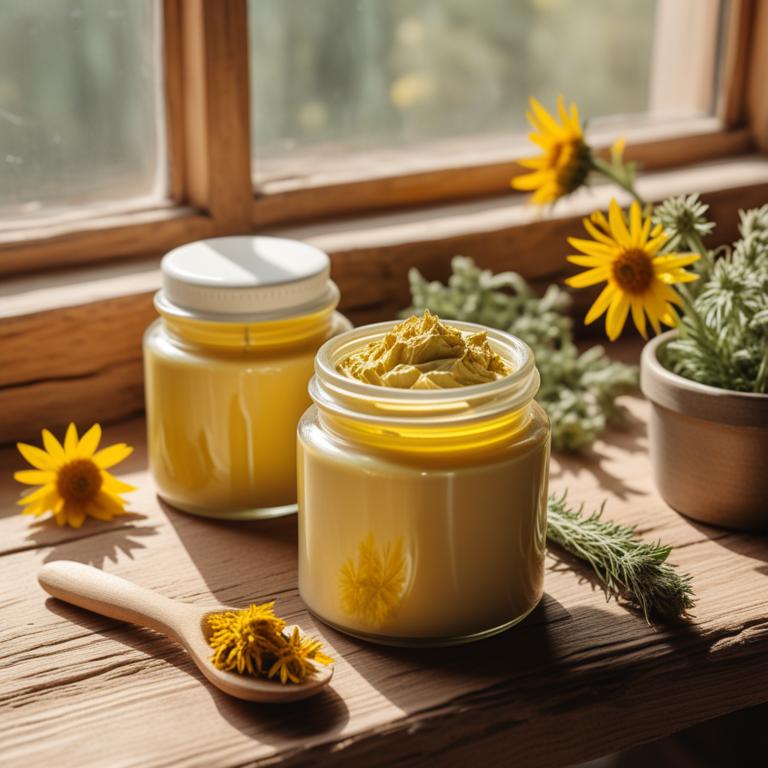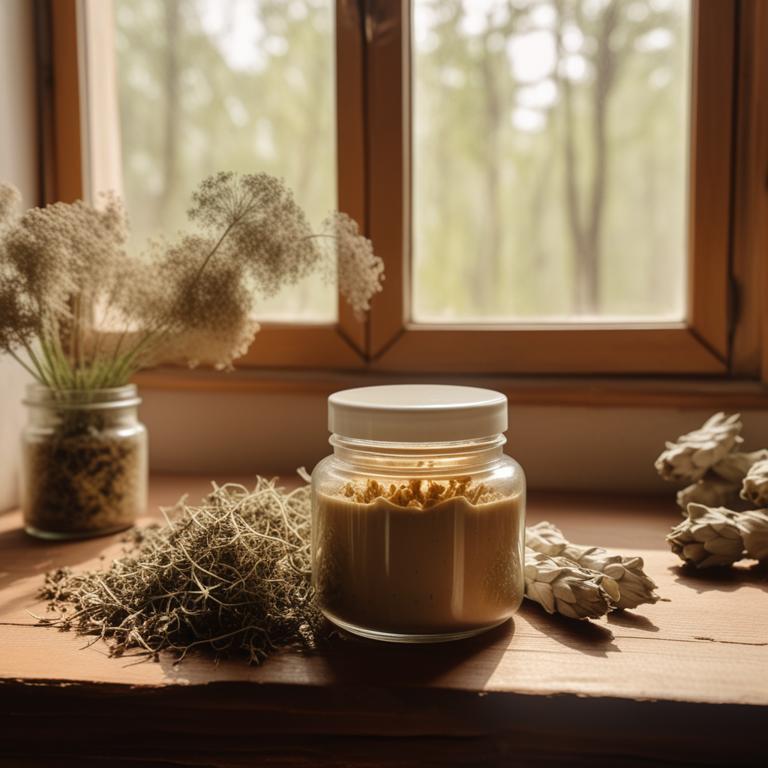7 Best Herbal Creams For Rashes

Herbal creams for rashes are topical preparations made from various plants and herbs, used to soothe, calm, and treat skin irritations and rashes.
These creams have numerous benefits, including reducing inflammation, preventing infection, and promoting faster healing.
Examples of herbal creams used to treat rashes include Aloe Vera gel to moisturize and soothe the skin, Calendula cream to reduce inflammation and promote healing, Tea Tree oil to combat bacterial infections, and Chamomile cream to calm and relax the skin.
Additionally, other herbs like Coconut oil, Turmeric, Cucumber, and Oatmeal are also used in herbal creams to treat rashes due to their anti-inflammatory and soothing properties.
According to "Zeitschrift fur Hautkrankheiten", creams for rashes such as Kamillosan cream have shown equieffective or superior therapeutic results compared to other treatments like hydrocortisone and bufexamac for conditions like neurodermitis.
Below there's a list of the 7 best herbal creams for rashes.
- 1. Calendula officinalis creams
- 2. Chamomilla recutita creams
- 3. Aloe barbadensis creams
- 4. Arnica montana creams
- 5. Rhus toxicodendron creams
- 6. Hypericum perforatum creams
- 7. Symphytum officinale creams
Also you may be interested in...
TODAY'S FREE BOUNDLE
Herb Drying Checklist + Herbal Tea Shopping List + Medicinal Herbs Flashcards
Enter you best email address below to receive this bundle (3 product valued $19.95) for FREE + exclusive access to The Aphotecary Letter.
$19.95 -> $0.00
1. Calendula officinalis creams

Calendula officinalis creams have been used for centuries to treat various skin ailments, including rashes, due to their anti-inflammatory, antimicrobial, and antioxidant properties.
The bioactive constituents of Calendula officinalis, such as triterpenoid saponins and carotenoids, help to soothe and calm irritated skin, reducing redness and itching associated with rashes.
These creams work by promoting wound healing, reducing inflammation, and inhibiting the growth of bacteria and other microorganisms that can exacerbate the condition.
The benefits of using Calendula officinalis creams to treat rashes include reduced discomfort, faster healing times, and a lower risk of infection, making them a popular natural remedy for this common skin issue.
Related Study
According to "Phytomedicine : international journal of phytotherapy and phytopharmacology", Calendula officinalis creams for rashes have been found to exhibit anti-inflammatory effects, promote wound healing, and alleviate symptoms of atopic dermatitis when used in conjunction with other herbs, specifically Cortex Moutan and Herba Menthae, in a three-herbs formula.
2. Chamomilla recutita creams

Chamomilla recutita creams are a popular herbal preparation used to treat rashes and skin irritations, offering a natural and soothing solution for individuals affected by this common ailment.
The anti-inflammatory and antiseptic properties of Chamomilla recutita creams help to reduce redness, itching, and swelling associated with rashes, promoting a swift recovery and alleviating discomfort.
The bioactive constituents, including apigenin and luteolin, present in Chamomilla recutita creams, contribute to their therapeutic effects by modulating the immune response and reducing oxidative stress, ultimately leading to the resolution of rashes.
The benefits of using Chamomilla recutita creams to treat rashes include reduced inflammation, improved skin health, and a decrease in the risk of skin infections, making it a valuable and effective herbal remedy for this condition.
3. Aloe barbadensis creams

Aloe barbadensis creams have been widely used to treat rashes and other skin irritations due to their soothing, anti-inflammatory, and antimicrobial properties.
The polysaccharides, vitamins, and minerals present in aloe vera help to reduce inflammation and promote wound healing, thereby alleviating the symptoms of rashes.
The bioactive constituents, including aloin, aloe-emodin, and acemannan, possess potent anti-inflammatory and antiseptic properties that aid in treating rashes by preventing infection and promoting skin repair.
The benefits of using aloe barbadensis creams to treat rashes include reduced itching, inflammation, and pain, as well as faster healing and improved skin texture.
Related Study
According to "Tropical medicine & international health : TM & IH", Aloe barbadensis creams for rashes, such as psoriasis, have been shown to be effective in reducing symptoms and clearing plaques in 83.3% of patients, with a significant decrease in PASI scores.
4. Arnica montana creams

Arnica montana creams have been widely used to treat rashes and skin irritations due to their anti-inflammatory and soothing properties.
The bioactive constituents present in Arnica montana, such as sesquiterpene lactones and flavonoids, help to reduce inflammation and promote healing of the affected skin.
These creams work by reducing redness, swelling, and itching associated with rashes, providing relief and comfort to the individual.
The benefits of using Arnica montana creams to treat rashes include reduced risk of scarring, faster healing times, and a decrease in the severity of symptoms.
5. Rhus toxicodendron creams

Rhus toxicodendron creams are a natural herbal preparation used to treat the rashes caused by urushiol oil, a common allergen found in poison ivy, oak, and sumac.
The creams contain anti-inflammatory and antihistamine properties, which help to reduce itching, redness, and swelling associated with the rash.
Bioactive constituents such as salicylic acid, glycosides, and flavonoids in Rhus toxicodendron creams help to soothe the skin, reduce inflammation, and promote healing.
The benefits of using Rhus toxicodendron creams include fast relief from itching and discomfort, reduced risk of infection, and promotion of skin regeneration, making it a popular natural remedy for treating urushiol-induced rashes.
6. Hypericum perforatum creams

Hypericum perforatum creams, also known as St. John's Wort creams, are a topical herbal preparation used to treat skin rashes and other dermatological issues.
The anti-inflammatory and antiseptic properties of this herbal preparation help to soothe and calm irritated skin, reducing redness and discomfort.
The bioactive constituents of Hypericum perforatum, including hypericin and hyperforin, have been found to possess phototoxic and anti-inflammatory properties, which contribute to its effectiveness in treating skin rashes.
Regular use of Hypericum perforatum creams can provide benefits such as rapid healing, reduced inflammation, and improved skin health, making it a popular natural remedy for treating various skin rashes and ailments.
Related Study
According to "BMC veterinary research", Hypericum perforatum creams for rashes have been shown to have antibacterial and antifungal effects, making them an interesting option for the treatment of skin diseases in dogs.
7. Symphytum officinale creams

Symphytum officinale creams have been traditionally used to treat rashes and skin irritations due to their anti-inflammatory, antimicrobial, and soothing properties.
The bioactive constituents present in these creams, such as allantoin and mucilages, help to reduce inflammation, promote wound healing, and protect the skin from further irritation, thereby alleviating the symptoms of rashes.
These creams also possess antioxidant properties, which help to neutralize free radicals and promote the repair of damaged skin tissues, ultimately leading to the resolution of rashes.
The use of Symphytum officinale creams has been associated with numerous benefits, including reduced itching, improved skin hydration, and accelerated healing of skin lesions.
Related Study
According to the given study, Symphytum officinale creams for rashes appear to have a positive effect on wound healing.